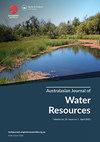Aquifer Characterization: The Case of Hawassa City Aquifer
IF 2.2
Q2 WATER RESOURCES
引用次数: 1
Abstract
Hydrogeologists and other water experts agree on that the effective groundwater management requires: firstly, a good understanding of the aquifer system; secondly, identification of practical measures to control abstraction; and thirdly, improvement in groundwater resource through artificial recharge. A 16 years’ pumping test and drilling lithology data and productive 29 wells were used to characterize the aquifer parameters of the Hawassa City, Ethiopia. The aquifer system was characterized physically, potentially, spatially, quantitatively, and qualitatively using AquiferTest software by applying Moench method to pumping test response data considering the basic assumptions in the model. Weathered and fractured pumice, basalt Scoriaceous rocks, fine-to-coarse-grained sand, and weathered ignimbrites are major water-bearing formations found from the analysis. High porosity and permeability due to these fractures are found to be a risk for the easy contamination of the ground water from surface wastes especially at the shallow aquifer water areas. Spatially, the southern corner and the lake shore of the city were identified as a huge potential area. Percentage of recovery results are 95–100% and transmissivity varies from 4.77 × 10−4 m2/s to 1.75 × 101 m2/s. This follows the general pattern of increasing value from east to west, that is, the value increases from the upper part of the basin to the lower. Moreover, the annual ground flow vector map of the area was developed using static water level data to see the direction of subsurface flow in the area. Accordingly, a large magnitude of water flowing from the central and west directions to the lake shore is identified showing similar profile with the surface flow.含水层特征:以哈瓦萨市含水层为例
水文地质学家和其他水资源专家一致认为,有效的地下水管理需要:首先,对含水层系统有很好的了解;二是确定控制抽象的实际措施;第三,通过人工补给改善地下水资源。利用16年的抽水试验、钻井岩性数据和29口生产井对埃塞俄比亚Hawassa市的含水层参数进行了表征。利用AquiferTest软件,根据模型中的基本假设,应用Moench方法对抽水试验响应数据进行了物理、潜力、空间、定量和定性表征。风化和断裂的浮石、玄武岩碎屑岩、细粒至粗粒砂和风化的火成岩是分析中发现的主要含水地层。由于这些裂缝的高孔隙度和高渗透率被发现是地表废物容易污染地下水的风险,特别是在浅层含水层水域。在空间上,城市的南角和湖岸被确定为一个巨大的潜在区域。回收率为95 ~ 100%,透过率为4.77 × 10−4 m2/s ~ 1.75 × 101 m2/s。这符合自东向西递增的总体规律,即从盆地上部向下部递增。此外,利用静态水位数据绘制了该地区的年地面流矢量图,以了解该地区的地下流方向。因此,确定了从中部和西部流向湖岸的大量水流与地表水流具有相似的剖面。
本文章由计算机程序翻译,如有差异,请以英文原文为准。
求助全文
约1分钟内获得全文
求助全文
来源期刊

Australasian Journal of Water Resources
WATER RESOURCES-
CiteScore
5.10
自引率
21.90%
发文量
25
期刊介绍:
The Australasian Journal of Water Resources ( AJWR) is a multi-disciplinary regional journal dedicated to scholarship, professional practice and discussion on water resources planning, management and policy. Its primary geographic focus is on Australia, New Zealand and the Pacific Islands. Papers from outside this region will also be welcomed if they contribute to an understanding of water resources issues in the region. Such contributions could be due to innovations applicable to the Australasian water community, or where clear linkages between studies in other parts of the world are linked to important issues or water planning, management, development and policy challenges in Australasia. These could include papers on global issues where Australasian impacts are clearly identified.
 求助内容:
求助内容: 应助结果提醒方式:
应助结果提醒方式:


